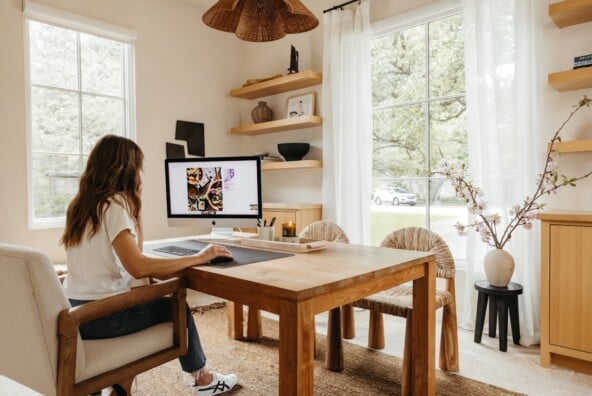We talk a lot about decluttering our physical spaces, but what about our digital ones? Given that we’re spending more and more time in front of our devices these days, investing in organizing them makes good sense. If you’re like most people, you’ve probably got old devices you’re afraid to toss, a mass of photos you’re afraid to look through, and multiple copies of files you’re afraid to delete. We’re here to take the fear out of digital decluttering, and show you how you can clean up your digital space for the new year in simple, doable steps.
featured image by sadie banks photography

Delete apps you don’t use.
The first step is super easy — go through apps on all your devices (phone, tablet, computer) and delete any apps you don’t use. Be a ruthless editor. You can always download them again if you change your mind.
Update all of your devices and apps.
Take the time to update all of your devices (and set them to automatically update if you can.) And now that you’ve cleaned out your app folders, go ahead and update all apps as well.
Purchase an external hard drive.
An external hard drive is key to keeping your devices clean (especially if you’re the type who likes to digitally hoard files from old jobs, school assignments, and personal projects.)
Think of the external hard drive as the digital equivalent of storing ski clothes in the attic — this is a place for things you only need access to on occasion.
Ideally, you’ll organize all the files on your external hard drive so it’s easy to sort through them when you need to. But, as a faster Plan B, you can always create a “to be sorted” folder on your external hard drive and comb through it later. Once you’ve got the files safely stored on the external hard drive, go ahead and delete them from your computer.

image via pretty pics delightful tips
Rescue important files from old devices and sell them NOW.
Are there important photos, videos, and files trapped inside dusty devices sitting in the back of your closet? If so, you’ll feel so much better once you’ve taken the time to move those files to a safe place. (This is where that external hard drive comes into play again.) Block off an afternoon and comb through those old devices to find the files you want to keep, then restore them to factory settings and get them out the door — either by donating them or re-selling them. You can expect to get about 25-30% back on used electronics if they’re less than 5 years in old and in good shape.
Start working from an external server.
This is what people are talking about when they say something is “on the cloud.” An external server is a place where files can be stored and synchronized from different devices. Bear with me. Here’s an example of how it works: Let’s say you’re working on writing a short story that currently exists as a Microsoft Word document on your desktop. You want to be able to work on the story while you’re visiting your parents in Omaha. Back in the day, that meant you either had to take your entire desktop computer with you to Omaha, or create multiple versions of the document. Now days — if you save the story to an external server before you hit the road — you can sit down at your mom’s computer, edit and save the document on an external server, and enjoy access to the updated document when you get home. You can access an external server through a service like Dropbox, Google Drive, or iCloud.
Get in the habit of working from an external server and say goodbye to confusing multiple versions of documents. You’ll also be freeing up space on your computer that will allow your machine to run faster.

image by marie claire
Use folders.
Folders are key to organizing your digital space, especially if you have a lot of files saved on your computer. I use folders to organize all of my documents, photos, videos, and music. Whether your files are saved on an external server, external hard drive, or your personal device, take the time to organize them into appropriately named folders. Doing this will minimize visual clutter and allow you to quickly locate the files you need.
Develop a good file naming protocol.
Now we’re getting down to micro level organization, aka the nerd stuff. Developing good file and folder naming protocols will make life easier, especially if you’re managing a high volume of files. Naming files is personal, and everyone does it a bit differently. So take some time and think about what will work best for you. Personally, I like to name my files with the file type, subject matter, and any relevant technical specifications. Here’s an example:
instagramVideo_SurfriderHotel_FullEpisode_1080p.mp4
I told you, nerd stuff.

Develop good weekly digital housekeeping habits.
Your devices are now updated, cleaned out, and organized to the max. You’re running lean and mean, and the key to keeping it that way is to develop weekly habits that make managing files easy. I take time each Friday to delete files I no longer need (especially photos and videos from my phone, which tend to build up fast), and to continue to sort new files into their appropriate folders. You’ll also want to make sure that you’re staying on top of your software updates each week. These practices, combined with working from an external server, will make keeping things clean easier than ever moving forward. Save and CLOSE!





